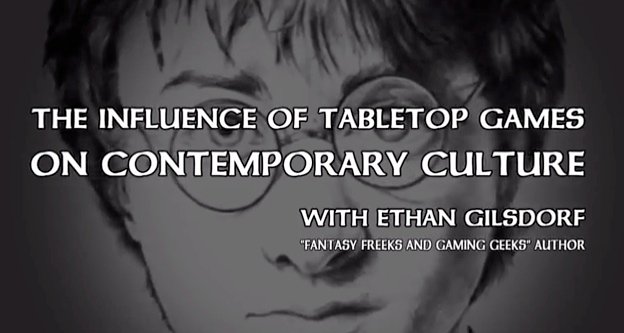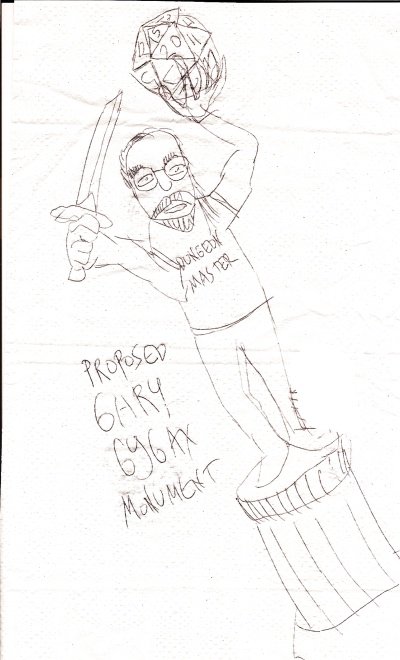How is a lawyer like a wizard? D&D goes to Harvard (and so do I
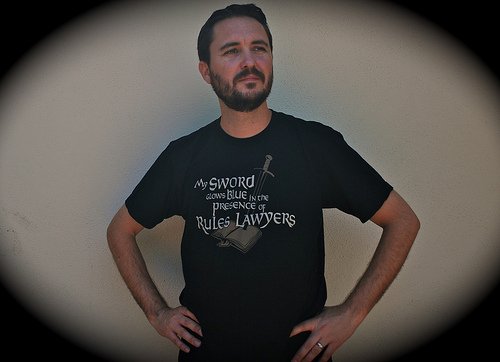
 Wil Wheaton's dream: to have a T-shirt that says "My sword glows blue in the presence of rules lawyers."
Wil Wheaton's dream: to have a T-shirt that says "My sword glows blue in the presence of rules lawyers."
How is a lawyer like a wizard? How does a courtroom resemble an epic battle? How is a casebook like the Dungeon Master's Guide?
I'm excited to be part of the "Berkman luncheon series" to give a talk called "How Dungeons & Dragons and Fantasy Prepare You for Law and Life," February 11, 2014, 12:30pm, at Harvard's Berkman Center for Internet & Society.
For this event, I'll be appearing in conversation with Jonathan Zittrain, a Harvard wizard (Professor at the Harvard Law School, Harvard Kennedy School of Government, and Professor of Computer Science at the Harvard School of Engineering and Applied Sciences, and co-founder of the Berkman Center for Internet & Society --- whew!).
We'll discuss such issues, with the audience, as: How the skills, rulebooks and "laws" required to play D&D --- whether understanding complex "to hit" charts or inventing the backstory of an evil Witch King -- can especially apply to law students; the push and pull of laws and rules vs. imagination in a game like D&D, a book series like Harry Potter, or any fantasy world; and the role of the dungeon master/author/world-builder in the consistent (or inconsistent) application of these rules and standards, and how this all might apply to the imaginary world of law, too.
It is free and open to all, but please an RSVP here. You can also see it webcast live here as well, where you can also get more information.
More info on Ethan-themed events here.
The Original D&D Gets a New Deluxe Edition
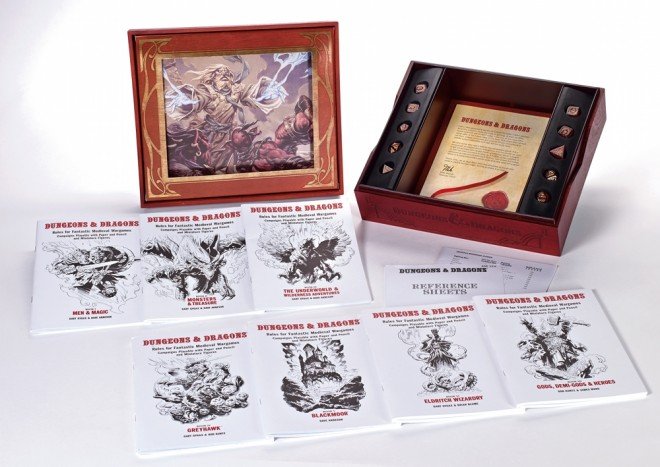

by Ethan Gilsdorf
Dungeons & Dragons (D&D) may be approaching its 40th birthday next year, and rapidly losing younger players to the irresistible eye-candy of digital gaming. But in one particular sector, the role-playing game business is still booming: Older gamers like me.
I grew up playing D&D, religiously, back in the Reagan Administration. My original "Monster Manual," "Dungeon Master Guide" and sack of polyhedral dice are still precious to me. Lucky for me, I hung onto my trove of rule books that were still covered with a layer of Cheetos dust. Other old-school games weren't so lucky. ("Thanks, Mom, for giving my stuff to Goodwill when I went off to college!") Now all grown up, and sometimes with children of their own, these gamers miss that place that face-to-face dice-rolling and storytelling experience played in their lives.
But fear not, old-school roleplaying games (RPGs) are back, one reissue at a time.
Wizards of the Coast (WotC), the company that owns the D&D brand, has embarked on a new campaign in the past year to recapture older gamers whose magic-users and paladins slayed many an orc and beholder and pillaged many a graph-paper-charted land. All year longWotC has been reprinting new editions of ancient tomes from the heyday of tabletop role-playing games. On November 19, the granddaddy of them all arrives: a deluxe edition of The White Box, the original D&D set (aka OD&D) first published by Tactical Studies Rules, or TSR, Inc, back in 1974. (In a Wired.com exclusive, a new photo of the final product prototype is pictured here.)
The White Box "was the very first roleplaying game, introducing concepts that have persisted throughout later editions," said Liz Schuh, director of publishing and licensing for D&D. "Many of our players have strong emotional connections to our classic products."
They better. This new White Box retails for $149.99.
All this nostalgia comes as D&D hits "middle age." In 2014, D&D, the first-ever commercially-available role-playing game, turns 40. Next year also brings (barring any delays) the release of the game's next iteration, D&D Next.
Is all this product retread a crass commercial move on the part of WotC, or a genuine desire to re-connect gamers in their forties, fifties and even sixties to their beloved dungeon-crawls pasts?
Whatever the interpretation, this is some powerful Spell of Nostalgia that WotC is casting. Go ahead, resist. Roll a saving throw versus
The campaign began last year, with new limited-editions of the 1st Edition rulebooks: the beloved AD&D "Monster Manual" (1977), "Player's Handbook" (1978), and "Dungeon Master’s Guide" (1979). Then, in January, WotC launched dndclassics.com, a site allowing oldbies to download in PDF format hundreds of forgotten and out-of-print gaming products, from the legendary 1978 module D3: Vault of the Drow to a 1981 edition of the D&D Basic Rulebook. Also released earlier this year: two volumes of compilations of classic adventures including one called "Dungeons of Dread" that features favorites like "Tomb of Horrors" and "Expedition to the Barrier Peaks." Second edition core rulebook "Premium" reprints came out in in May. Of course, official D&D merch --- from T-shirts, belts and iPhone cases --- is also being hawked. All of these products are replicated down to the last "to hit" chart and goofy drawing of kobolds, and gelatinous cubes (just testing you: gelatinous cubes are invisible).
That "White Box" facsimile set includes the original three OD&D booklets (Men & Magic; Monsters & Treasure; Underworld & Wilderness Adventures) plus the four supplements (Greyhawk; Blackmoor; Eldritch Wizardry; Gods, Demi-Gods & Heroes); a packet of "reference sheets"; and 10 funky-looking (but not historically accurate) dice. In a nod to the OD&D's original brown wood-grain cardboard box, it's all housed in a fancy engraved wooden case. The booklets' interior art looks the same, but the box's cover modern fantasy art (see photo) might annoy purists.
Original "white box" sets are rare, and can sell for $500 or more on eBay. With the reprints, anyone can own a piece of D&D history. Sort of.
Game designer James M. Ward, a veteran TSR employee who wrote the games Gamma World and Metamorphosis Alpha, and co-authored the core rulebook Deities & Demigods, took a more skeptical view towards WotC's decision to release items from the game's golden age. "Just think of the profit for releasing something they didn’t have to pay for or edit," Ward said. "It’s a move to make lots of money considering consumers are really liking the idea of old style material."
From the tabletop resurgence that’s been happening over the past few years, it’s clear that older gamers miss the dice-rolling and face-to-face interaction of an analog dungeon crawl. Even the the original TSR brand had been rebooted (not by Gygax's heirs or Wotc) and has released a publication, aptly named Gygax Magazine, in the spirit of the old Dragon and White Dwarf magazines. GenCon, Pax and Pax East prove there's an audience for non-digital entertainment. Older school-style RPGs such Pathfinder, from rival company Paizo Publishing, routinely outsells the last version of the D&D, the much-maligned 4th edition, released in 2008.
This "Old School Renaissance" is a welcome resurgence for people like Tim Kask, the first employee TSR ever hired and former editor of "Dragon" magazine. Kask and other older gamers maintain that newer iterations of D&D stripped out all the fun. "The game got so tabulated and charted that people forgot to ask questions," he said. "I think what has been ruled to death is that sense of wonderment, of not exactly knowing what is around the next corner."
So it makes sense that WotC also hopes some of the gamer will find their way back to a purer form of D*&D -- namely, the storytelling and mystery. "When you lose that, roleplaying," Kask said, D&D "becomes just killing at the zoo.”
If Wizards of the Coast wants to take old gamers like me on a journey down memory lane -- or back into memory's dungeon -- I can't complain. Maybe I'll never play that fancy White Box edition. In fact. I'm pretty wedded to my AD&D rule set from the 1980. But just to hold these new/old tomes, and flip through them, and roll the dice again ... Ahhh. Gary Gygax and Dave Arneson, D&D's co-creators, may be dead, but their legacy of Doritos-eating, dice-rolling and bantering around some basement table lives on. Hopefully, with these D&D reissues, enough younger players will also find their way to that experience.
So even if your original DM's Guide got tossed back in the Reagan Administration, you can game again, and play whatever version of D&D you like.
"From my way of thinking," James M. Ward said, "nothing was lost."
How D&D changed my life and the life of Brian "Clerks" O'Halloran

I had a great time at the Boston Festival of Indie Games, geeking out and waxing nostalgic with Brian "Clerks" O'Halloran about how D&D changed (and warped) our lives and saved our asses.
Our slide-lecture / unreheased stand-up comedy talk was officially called:
"Back in the Dungeon – A conversation with Brian O’Halloran and Ethan Gilsdorf on how D&D changed their lives"
Digital gaming all began with graph paper dungeons, a handful of dice and the Monster Manual. Join actor Brian O’Halloran (“Dante Hicks” in Clerks) and writer and critic Ethan Gilsdorf (author of Fantasy Freaks and Gaming Geeks) as they geek out about the importance and impact of Dungeons & Dragons and other RPGs and tabletop games on the gaming industry, and how these old-school games changed their lives for good, not evil (mostly). There’ll also be giveaways of Ethan’s book and other goodies We’ll end with a Q&A, book signing, and autograph session immediately following the event.
Thanks Brian and thanks BostonFIG.
Announcing, Dungeons & Dorkwads!
 Let the dork-offs begin!
Let the dork-offs begin!
Announcing Dungeons & Dorkwads, a site for all things D&D, nostalgia and bad jokes. In our first post, Noble Smith and I geek out about a 1970s Smaug the Dragon miniature figurine and its resemblance to Pinky Tuscadero, the Fonz's +7 Motorcycle of Shark Tank Jumping, and a hobby shop called Unicorn Castle where they had girls for sale.
What are we trying to accomplish? We’re not sure. What is our mission statement? We don’t have one (yet). But what is this site all about? Dorking-off.
What is a dork-off, you ask? Noble and Ethan, we are not-so-youthful dorks, with an unhealthy attachment to the role-playing games of our glory years — D&D especially — and assorted fantasy, science fictional and pop cultural artifacts. Here at Dungeons & Dorkwads, we exhume and celebrate these lost relics, be they worn dice, faded hand-drawn maps, broken lead figurines, beat-up Tolkien boxed sets or Hoth or Happy Days dioramas. (We’d like to see one that combines both universes.) Then, we geek out about them.
What stories do they unleash from the Tomb of Memories? What did it all mean to us? Were those years in the dungeon a complete waste? We think not. Along the way, we let these dork-offs take us in whatever direction that pleases us. Expect side trips to the lands of Tatooine, Middle-earth, Gilligan’s Island, Lego, and Loni Anderson.
- See more at: http://www.dungeonsanddorkwads.com/whats-a-dork-off/#sthash.unqTcAjf.dpuf
I'm on PBS's "Off Book" to discuss D&D
Dungeons & Dragons Is Evil Again
Yes! D&D is Evil Again! Pat Robertson scares us like it's 1982
Save vs. disbelief.
Pat Robertson, former Southern Baptist minister, Chairman of the Christian Broadcasting Network and erstwhile presidential candidate, had this to say last week about the latest blight on America: Dungeons & Dragons.
Wait — Dungeons & Dragons? Yes, D&D is back. And it’s more evil than before.
This would be amusing, if it wasn’t so scary.
Once again, from the front lines or bowels of pop culture, we find another freak out by those who are clueless. No, it’s not violent video games that are poisoning the minds (or loins) of America’s youth. Nor is it the Internet, or texting, or sexting, or Facebook or Twitter. Nor is it rap, or hip hop, or raves, or Oxycontin, or punk, or comic books, or Pixie Stix, or Pop Rocks.
Worse: D&D. That old-fashioned game of dice and graph paper and demonic possession.
It’s as if Robertson was encased in carbonite back in 1980, only to be thawed out by a benevolent Boba Fett three decades later. As if Roberston’s never even heard of Call of Duty, let alone Harry Potter or Pac-Man. And magically, still dripping wet from the dry ice and experiencing the brain freeze of a lifetime, he keeps jabbering away on his show The 700 Club, about magic and evil and the occult, and D&D which, in his words, “it was, like, demonic.” (Yes, he actually, like, said, “like.”) “Stay away from it,” is his advice, in 2013.
Read the rest of my post on GeekDad.
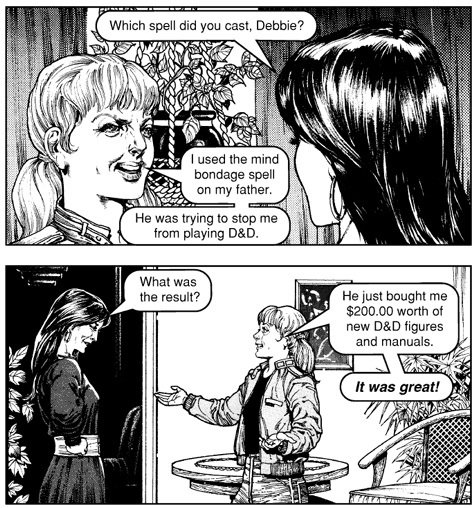 Jack Chick’s infamous 1984 anti-D&D comic book, “Dark Dungeons.” Ooh. Scary. (Image: Chick Publications)
Jack Chick’s infamous 1984 anti-D&D comic book, “Dark Dungeons.” Ooh. Scary. (Image: Chick Publications)
Exploring the origins of D&D for Wisconsin Public Radio
Dungeons and Dragons is the single most famous roleplaying game in the world. Writer Ethan Gilsdorf didn’t grow up in Wisconsin, but his love of D&D led him to fantasize about visiting the game’s hometown: Lake Geneva, hometown to Dungeons & Dragons co-creator Gary Gygax. In this cool radio piece, Ethan explores the origins of D&D for Wisconsin Public Radio.
Or you can listen to the mp3 here.
Mitt Romney as a D&D Character?
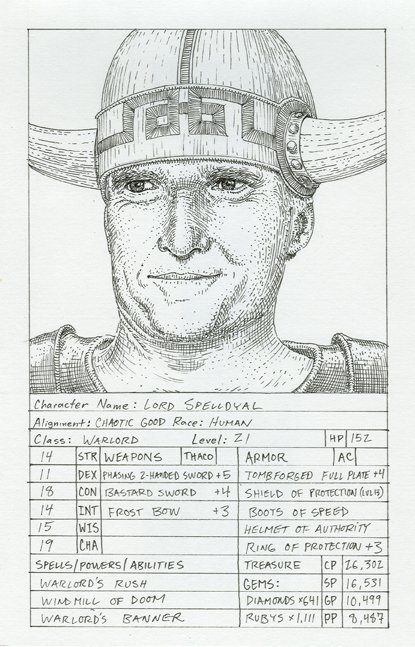 Now that Presidential candidate Mitt Romney is wailing on his opponents Newt, Rick, and Paul, perhaps it's time for his deeds to be enshrined as a D&D character.
Now that Presidential candidate Mitt Romney is wailing on his opponents Newt, Rick, and Paul, perhaps it's time for his deeds to be enshrined as a D&D character.
Artist Casey Jex Smith has been working on a series of works that depict people as D&D characters. Here, Mitt Romney, although unnamed, is shown as Lord Spelldyal, a 21st level warlord with 152 hit points, Boots of Speed and a Helmet of Authority.
The drawing was one of the works in the Dungeons and Dragons On & Ever Onward art show at the Soho Gallery of Digital Art in New York City. The show, which closed Jan 11, 2012, was curated by Timothy Hutchings, and featured works by Casey Jex Smith, Ryan Browning, Sean McCarthy, Rebecca Schiffman, Josh Jordan, Jeffrey Brown, Giovanni Garcia-Fenech, Chris Bors, Owen Rundquist, Andrew Guenther Jason Phillips, Ketta Ioannidou, Fiona MacNeill, Kitty Clark, Erol Otus, Steve Zeiser, Matt Brinkman, Chris Coy, and others.
And it featured historical selections from the Play-Generated Maps and Documents Archive.
More from Casey Jex Smith's D&D characters series here.
Image courtesy Allegra LaViola Gallery
[a version of this post originally appeared on wired.com's GeekDad]
Gygax Biopic in the works
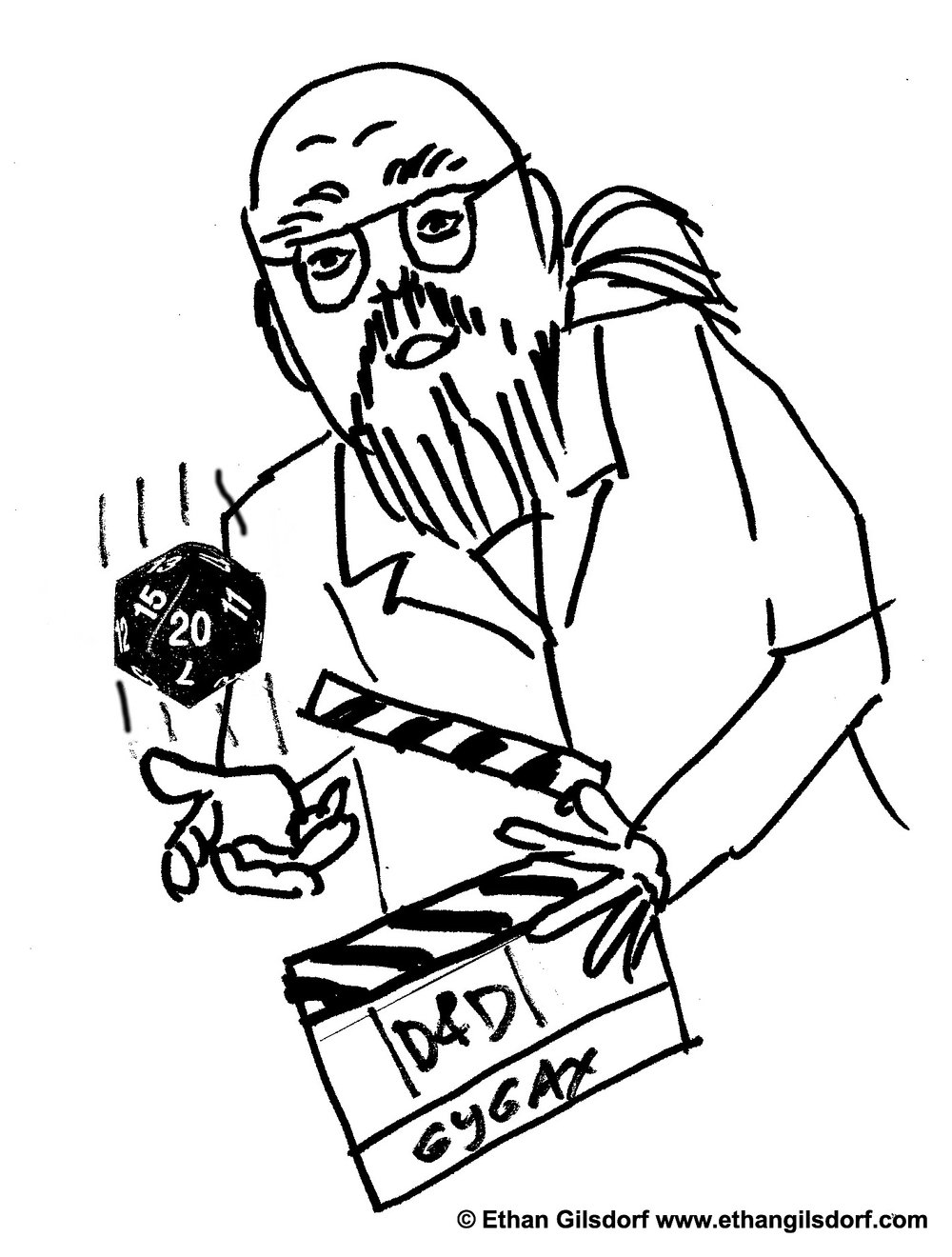 The Examiner.com has reported and confirmed a rumor that’s already been echoing through the dungeons of D&D talk: that a Gary Gygax biopic is in the works. Michael Tresca wrote:
The Examiner.com has reported and confirmed a rumor that’s already been echoing through the dungeons of D&D talk: that a Gary Gygax biopic is in the works. Michael Tresca wrote:
George Strayton confirmed he is … the scriptwriter for a $150 million movie based on Gary Gygax’s life. George describes the film as a ‘combination action movie and bio pic.’ The movie will tell the story of how Gary created Dungeons & Dragons, switching between his real life and the fantasy realm of Dungeons & Dragons.
Strayton is the CEO/Lead Designer of Secret Fire Games, as well as a writer for TV series Hercules: The Legendary Journeys andXena: Warrior Princess, and the animated feature Dragonlance: Dragons of Autumn Twilight.
Another morsel: Tresca said that “George let it slip that a ‘huge star is playing Gary.’”
I’m game.
That said, some skeptical voices have already begun to pepper the blogosphere. As James Maliszewski says over at Grognardia, “I’d frankly be amazed if any studio thought that the life of Gary Gygax had enough mass appeal to be made into a movie, let alone one with a big budget and a huge star.” It’s an excellent question.
This certainly raises the question if the non-nerd world is ready for a biopic on an essential, but for many, still unknown pop culture innovator who helped usher in a new gaming and leisure genre. The Whole Wide World, the 1996 film about Robert E. Howard, creator of Conan the Barbarian, and starring Vincent D’Onofrio and Renée Zellweger, proved that more obscure subjects for biopics can be made. But … while that film was largely well-received critically, it tanked at the box office.
The life of Gygax and genesis of D&D certainly sounds like a promising idea for a movie. Who among lovers of RPGs won’t want to see the reenactments of D&D’s early years? Those behind-the-scenes scenes of early play-testing? And to settle once and for all the junk food dilemma — did Gary prefer Doritos or Cheetos?
More updates on this as I hear more.
Two New Books Lavish in 80s Video Game Culture
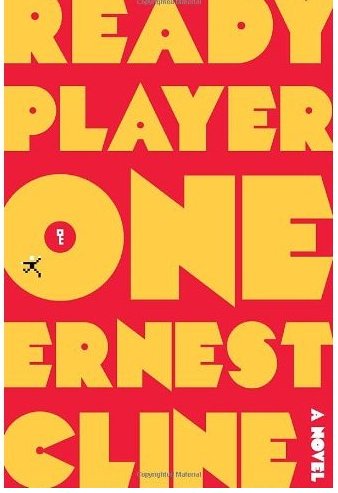 READY PLAYER ONE By Ernest Cline [Crown, 374 pp. $24.00]
READY PLAYER ONE By Ernest Cline [Crown, 374 pp. $24.00]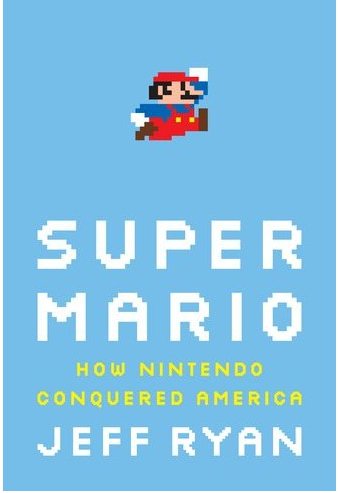 SUPER MARIO: How Nintendo Conquered America, By Jeff Ryan [Portfolio, 292 pp., $26.95]It’s easy to cast a long shadow of nostalgia across your geeky past, now that you are standing taller.
SUPER MARIO: How Nintendo Conquered America, By Jeff Ryan [Portfolio, 292 pp., $26.95]It’s easy to cast a long shadow of nostalgia across your geeky past, now that you are standing taller.
There’s no shame, no risk of ridicule or reprisal, now that nerds top the food chain. More confident, you might even find yourself admitting, “Sure, I used to play Dungeons & Dragons. Had an 18th-level paladin named Argathon. One righteous orc-slaying dude.’’
I do. I played more than my share of video and role-playing games during a less friendly era, the 1980s. Fantasy and science fiction had not come out of the closet. The financial success of genre franchises had not yet made geekery acceptable. Gaming culture was nonexistent.
A bonus of my then fringe game habit: It felt user-driven, indie, even subversive. When free time, not money, was my currency, gaming created a peculiar, and intimate, community. I inserted real quarters into singular machines shared with others. No Internet. No interruptions from texts. Total immersion in virtual worlds was possible even as, paradoxically, cutting-edge special effects were analog, not digital.
And a game of Donkey Kong, its chunky graphics about as sophisticated as the dungeons I sketched on graph paper, might last only a minute, while a game of D&D, limited to the primitive technology of dice, pencils, and brainwaves, would take months.
Differing both in approach and success level, two new books -- Ernest Cline’s dystopian sci-fi novel “Ready Player One’’ and Jeff Ryan’s historical reportage “Super Mario: How Nintendo Conquered America’’ -- plumb and pay tribute to the genesis of our gaming culture. To a time when to find out who was the best at Asteroids or Galaga, you hoofed it down to the mall to witness the heroism gracing the “high score’’ screen, where someone’s tag -- “ZAK’’ or “LED’’ -- was hallowed only in the halls of your local arcade.
 Ryan, a video game critic, painstakingly charts the Japanese company Nintendo’s startling success. When its 1980 Space Invaders rip-off Radar Scope failed, technicians retrofitted 2,000 of the machines with a new arcade game, designed by an underling named Shigeru Miyamoto. Donkey Kong was born, as was the character Mario, based on a real mustachioed landlord who once showed up at Nintendo’s US headquarters to collect the rent and “grew so incensed he almost jumped up and down.’’ The red overalls and hat came later.
Ryan, a video game critic, painstakingly charts the Japanese company Nintendo’s startling success. When its 1980 Space Invaders rip-off Radar Scope failed, technicians retrofitted 2,000 of the machines with a new arcade game, designed by an underling named Shigeru Miyamoto. Donkey Kong was born, as was the character Mario, based on a real mustachioed landlord who once showed up at Nintendo’s US headquarters to collect the rent and “grew so incensed he almost jumped up and down.’’ The red overalls and hat came later.
Ryan does a fine job describing Nintendo’s growing rivalry with Atari and Sega and subsequent shrewd moves, as arcades shuttered, to dominate the home console market. Super Mario Bros. became the “dense’’ game-changing killer app, Ryan writes, which “called for deep exploration instead of facile button mashing.’’ A new generation of gamers could explore endlessly, wandering tubes, hopping platforms, and collecting shells and coins. Nabbing the high score wasn’t the point. Mario helped kill quarter-based game culture.
Ryan can be insightful, and his prose colorful, but also distracting. Images and metaphors compete and clash - the Zucker Brothers follow Derrida, a music reference is slammed cheek-by-jowl with a baseball analogy. At times, the text seems translated from the Japanese. What is “a nebula’s improvement in graphics’’? A “veritable sleuth of unsold Teddy Ruxpins’’? It’s also difficult to picture the graphical evolution of Mario and his game world when the book has no illustrations.
Most frustratingly, we never hear directly from any Nintendo designers, not even Miyamoto or company head Hiroshi Yamauchi. Curiously little on-the-ground reporting of personal travails or internal corporate tensions. After the first 100 pages, the narrative devolves into a cheery laundry list of game releases. It’s as if Ryan reported the book from the distance of the Internet.
Still, “Super Mario’’ remains an important link to understanding how we got from Donkey Kong to Wii, and why the wee Jumpman still rules. “Mario is the id: working off of instinct, never having much of a plan, always able to leap into the middle of things. We all become younger as we play Mario, because when we’re Mario we simply play.’’
More so than Ryan, Cline banks on blatant nostalgia for our geeky pasts. The year is 2044 and the young protagonist of “Ready Player One,’’ 17-year-old orphan Wade Watts, narrates his own progress in an elaborate, online scavenger hunt. He lives as an economic refuge in a crime-ridden shanty town, “The Great Recession was now entering its third decade,’’ Watts says, and like many who have given up on the “real world,” he spends his waking hours as an avatar, named Parzival, in a massive, Matrix-like virtual space called OASIS.
Created by a reclusive, Reagan-era game designer, the game melds Tolkienesque riddles with ’80s pop arcana - from Matthew Broderick’s lines in “WarGames’’ to dungeons designed by D&D co-creator Gary Gygax. Solve the puzzles and you inherit the game designer’s vast fortune. An old-fashioned “high score’’ leader board pops up periodically in the narrative to remind us who’s winning.
Such is the post-apocalyptic, nerd-friendly premise of “Ready Player One.’’ Watts is one of thousands of other players known as “gunters,” or “egg hunters” because they are looking for Easter eggs, or clues, hidden in the thousands of designer virtual lands that populate the OASIS. Watts steeps himself in the period, eschewing the world of 2044 to effectively live and breathe the era’s most mundane factoids, memorizing characters from “The Breakfast Club,” plot points from “Star Wars,” tactics for an obscure arcade game like Joust. Clearly having fun with the reader, and himself, Cline stuffs his novel with a cornucopia of pop culture, as if to wink to the reader, “Remember the TRS-80? Wasn’t it cool?’’ The conceit is a smart one, and we happily root for Watts/Parzival and his gaming buddies on their quest for the big egg -- and hope they win before a villainous, corporate-run gaming guild declares “game over.’’
Not that the novel is without its problems. Cline, the screenwriter who gave us “Fanboys,’’ oddly chooses a first-person narrator. What is the occasion for a 17-year-old explaining the plot of “Blade Runner,’’ or that “ ‘2112,’ Rush’s classic sci-fi-themed concept album’’ hit record stores “in 1976, back when most music was sold on twelve-inch vinyl records’’? Long, awkward passages of exposition bog down the story, and conflict with Watts’s own distinctive narrative voice. A third-person, roving point of view would more logically allow for these passages of authorial intrusion. Also a bummer: Much of the action is virtual, statically describing Watts’s online moves: “I took a screenshot of this illustration and placed it in the corner of my display.’’
One can picture much of this working better on the big screen, where asides won’t be needed. We’ll hear “She Bop” on the soundtrack or see a character wearing a “Muppet Show” T shirt and get it. No surprise, Cline’s movie adaptation of Ready Player One has already been sold.
But ignore these narrative hiccups and “Ready Player One’’ provides a most excellent ride. Once the story is up and running, and the novel blasts to its world-ending climactic battle, I found the adventure story and its revenge of the dorks dream fully satisfying.
Both Cline and Ryan’s books lavish in the toys and pastimes of our youth. And also nostalgia, which may soft-focus the hard and real edges, and yet we're happy to lavish in it nonetheless. We aging humans traffic in it. Perhaps we must to make sense of our past lives.
Like the film “Super 8,’’ these two books play also into a final fantasy: that things were once simpler. Today, some attribute the violence in Norway, unfairly, to video games. Suddenly ’80s pop culture looks less troubled. But of course, the arcade and role-playing games of yore were controversial scourges bent on the destruction of youth. Remember?
Soylent Green, and Gaming, Is People: Final Thoughts From Gen Con
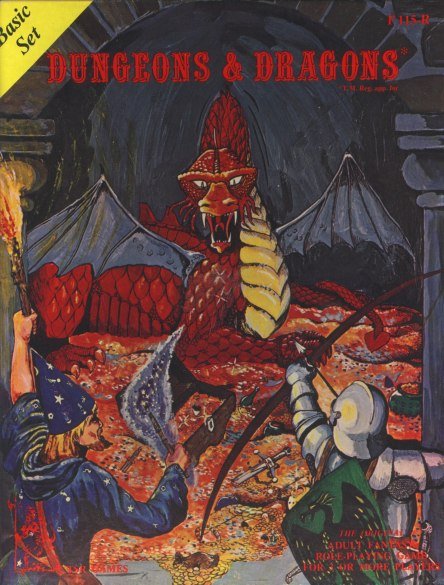 Is your Basic D&D set worth millions?The booths have been dismantled, the games put away, the green goblin face paint washed off, and the last of the trolls, pirates and grognards have been swept from the halls of the Indiana Convention Center.
Is your Basic D&D set worth millions?The booths have been dismantled, the games put away, the green goblin face paint washed off, and the last of the trolls, pirates and grognards have been swept from the halls of the Indiana Convention Center.
Gen Con may be over, but the ongoing campaign is not.
While of course the main reason gamers flock to Gen Con is to demo new product releases – and for sure, there were oodles of new merch on the convention floor, from Fantasy Flight Games’s Star Wars card miniature games to Wizards of the Coast D&D Neverwinter campaign setting – what I noticed, above all, was the spirit of gaming.
There's an ad in the Indianapolis Airpoirt about "gaming," but that ad means casino gambling: poker, blackjack, slots. What I mean, and what Gen Con ultimately aims to promote, is true gaming. Play that's not about beating the system or bilking other players of their riches, but sharing the experience of adventure and fun.
Gaming is people. (Soylent Green is also people, but that's another story.)
Reflecting back on my four days at Gen Con Indy, here are some final words about the power of table-top and role-playing games.

 All weekend long, I wandered the vendor floor, the hallways and game rooms, but I kept returning to the Gen Con auction. Here, folks unload old games of all types, from D&D products to an old copy of Tunnels and Trolls to a forgotten board game like Dark Tower or Pac-Man. On Friday night, the best of the best collector items were bid on and bought. I watched Kask and fellow TSR veteran game designer Frank Mentzer (founder of the Role-Playing Games Association), both serving as auctioneers, scrutinize an old D&D Basic set, trying to ascertain whether it was a first or third printing and whether the shrink wrap and Toys “R” Us sticker were authentic. I was fascinated by the love and passion these games attract, as well as the desire to get the details right. And the humor: After the winning bid on that Basic set, the auctioneers tore open the shrink wrap to see what was inside. (Sorry, winner, it was nothing special.) The desire to know the "guts" trumped any persnickety OCDism to keep the package intact for posterity's sake.
All weekend long, I wandered the vendor floor, the hallways and game rooms, but I kept returning to the Gen Con auction. Here, folks unload old games of all types, from D&D products to an old copy of Tunnels and Trolls to a forgotten board game like Dark Tower or Pac-Man. On Friday night, the best of the best collector items were bid on and bought. I watched Kask and fellow TSR veteran game designer Frank Mentzer (founder of the Role-Playing Games Association), both serving as auctioneers, scrutinize an old D&D Basic set, trying to ascertain whether it was a first or third printing and whether the shrink wrap and Toys “R” Us sticker were authentic. I was fascinated by the love and passion these games attract, as well as the desire to get the details right. And the humor: After the winning bid on that Basic set, the auctioneers tore open the shrink wrap to see what was inside. (Sorry, winner, it was nothing special.) The desire to know the "guts" trumped any persnickety OCDism to keep the package intact for posterity's sake.
Thankfully, more than just old timers are keeping the old RPGs alive. Publishing collectives like The Old School Renaissance Group and voices like the Blog of Holding are intent on honoring the groundbreaking heritage of D&D. A downloadable gaming product called Old School Hack is doing its best to introduce a streamlined, D&D-like RPG experience to a new generation of players. “A hack of a hack of the original Red Box version of a certain popular hack-and-slash fantasy game,” is what the folks say about their wee little product. Old School Hack also won the best free product “gold” award at Gen Con’s ENnies, the game industry’s version of the Oscars/Emmys. I applaud Kirin Robinson, the man behind OSH, who humbly notes, “I’m certainly not any sort of professional game designer, just another hobbyist looking to put together a fun game.” Here are all ENnie winners.
[Side note: In a funny, tongue-in-cheeky move, at the ENnie awards ceremony, every time Wizards of the Coast won a silver or gold, the “Imperial Death March” theme from the Empire Strikes Back would sound. Hanging out at their spectacular, ruined castle booth a lot this weekend, I know Wizards has a sense of humor.]
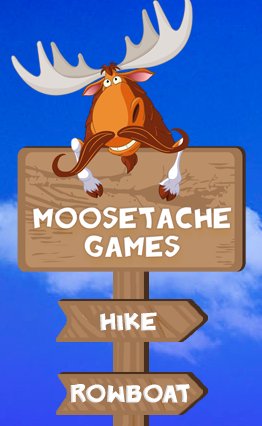 Moosetache Games: Teaching that not all kids games involve a video monitor and controllerSeriously, evil empire jokes and fancy booth bling aside, Gen Con also reminded me of about the enthusiasm of the hundreds of indie gamer designers who exhibit their dreams here. Their only hope? To get a few dozens players excited about their new adventure. Tiny companies, like Moosetache Games, who debuted their new card game Hike, a family card game that encourages cognitive learning and teaches children about nature, took the time to teach anyone who wanted to learn. After all, the best way to try a new game is to play it. And no better way than from the folks who make it.
Moosetache Games: Teaching that not all kids games involve a video monitor and controllerSeriously, evil empire jokes and fancy booth bling aside, Gen Con also reminded me of about the enthusiasm of the hundreds of indie gamer designers who exhibit their dreams here. Their only hope? To get a few dozens players excited about their new adventure. Tiny companies, like Moosetache Games, who debuted their new card game Hike, a family card game that encourages cognitive learning and teaches children about nature, took the time to teach anyone who wanted to learn. After all, the best way to try a new game is to play it. And no better way than from the folks who make it.
I also hung out with the folks behind an exciting new project, Dungeons & Dragons: A Documentary, who (like me) aim to tell the whole story of how a simple yet innovative, fantasy role-playing game changed the course of millions of lives, and the history of our culture. And how D&D is still inspiring people to be creative writers, thinkers, and problem-solvers .
And I spoke to Gail Gygax, wife of the late Gary Gygax, and their son Luke Gygax, who are intent on making sure that the legacy of Gary and his contributions to the game are remembered. They both gave a moving tribute to Gary at the ENnie awards. And their Gygax Memorial Fund is still soliciting donations. You can even record your own video testimonial for the website.
Which brings me back to my over-aching feeling upon departing Gen Con: that table-top, roleplaying gaming is really about people. Gaming brings folks together around a table to banter and bargain and be boisterous. To share a playful experience outside of work, responsibilities, outside of the boxes we have drawn around ourselves. Adults need as much free, unstructured down time as kids. Let’s not forget that. We need to goof off, too.
And as cool as richly-imagined digital worlds can be, in game playing, it's the quality and passion of the company around the living room table that count, not the impressive gadgets and graphics. This is a lesson we especially should teach kids, who need to understand that not all games need involve a video monitor and a digital graphics. The power of the raw imagination needs to be preserved.
Hope to see you at next year’s Gen Con (or any of the hundreds of smaller game cons that have sprung up, including Gary Con IV in March, 2012, where you can game with many gaming legends).
Now, go play a game. Have fun.
Gygax memorial makes progress
 Gary Gygax the way the folks at "Futurama" drew his cartoon versionLake Geneva, Wisconsin, was always a mythical land of enchantment to me, a kid raised far away on the east coast who spent much — OK, way too much — of his allowance on Dungeons & Dragons gear.
Gary Gygax the way the folks at "Futurama" drew his cartoon versionLake Geneva, Wisconsin, was always a mythical land of enchantment to me, a kid raised far away on the east coast who spent much — OK, way too much — of his allowance on Dungeons & Dragons gear.
While the mailing address — TSR Hobbies, Inc., POB 756, Lake Geneva WI 53147, U.S.A. — felt like an imaginary realm, I knew it was also a real land where that mysterious co-creator and co-godfather of D&D lived and worked: Gary Gygax.
When my local hobby shop didn’t have a module or rule book on their shelves, I’d mail in my order form directly to the source in Lake Geneva (with my check, of course, that covered the price plus “shipping and handling”). The elves and orcs who toiled there would fill my order, and in a few weeks I’d get a package in my mailbox. And the next crucial adventure could continue.
Ever since Gygax passed away in 2008, his widow Gail Gygax and others have spearheaded an effort to honor him and his contribution to gaming lore with a public monument in Lake Geneva. The Gygax Memorial Fund website just announced that goal is one step closer:
The Gygax Memorial Fund has reached a huge milestone. We have been granted land for the memorial site at Donian Park. Donian Park is a four acre open space site which encompasses a wetland and the 100 year recurrence interval floodplain along the White River in downtown Lake Geneva.
On the website for the Gygax Memorial Fund, there’s a link to donate, if you are so inclined. There’s also a forum to share your testimonials of how Gary and D&D changed your life for the better.
Long live Gary!
Geek love
Geek love
 Can a gaming and fantasy fanatic find romance outside his realm?
Can a gaming and fantasy fanatic find romance outside his realm?
By Ethan Gilsdorf
[originally published in the Boston Globe Magazine]
In a famous scene in the 1982 movie Diner, Eddie (played by Steve Guttenberg) makes his wife-to-be pass a football trivia quiz before he’ll agree to marry her. Me, I’m a fantasy and gaming geek, not a sports freak. I may not know how many yards Tom Brady has passed for this season, or the Red Sox bullpen’s average ERA last season, but I can name all nine members of the Fellowship in The Lord of the Rings, and I can tell you that the Millennium Falcon made the Kessel Run in less than 12 parsecs.
This has caused some problems in my dating life. Not that I’ve pulled a litmus-test stunt on prospective mates, like: Do you prefer DC Comics or Marvel? Can you name the houses at Hogwarts? Rather, it’s me who’s felt tested. Should I admit I once played Dungeons & Dragons religiously? That I was president of my high school AV Club? Revealing my dweebishness hasn’t always produced the best results. “Huh . . . interesting,” more than one lady has said on a first date during my epic quest for damsels, one that has taken me from Star Wars cantina-like dive bars to the heartless land of Mordor.com, er, Match.com. “I never knew Chewbacca was from the planet Kah . . . how do you say it?”
“Kashyyyk,” I muttered, sipping my ale and deciding I’d not sing my hobbit drinking song – not until at least the third date.
Because these utterances have at times been deal breakers, I’ve often mulled whether couples can bridge the differences. Can partners hail from opposite ends of the hipster-to-geek continuum or the nerd-jock divide? Need they share the same geekery to make love work? As a decorated veteran of the Dating Wars, I’m here to report the answer is mixed.
One woman I was obsessed with seemed cool with the idea of watching The Fellowship of the Ring with me. In bed. We barely made it out of the Shire. When I proposed a marathon, 12-disc extended edition viewing of the trilogy (including the “making of” videos), with Middle-earth themed food, she de-friended me. I went out with another woman whose online profile declared, “I’m a sci-fi geek.” We met up at a sports bar, where my “Han shot first” reference met a blank stare and my Monty Python jokes fell flat. It seemed her professed geekiness was only skin deep.
I once met a couple who found a solution, though. Both through-and-through geeks, they resided, surprisingly, in opposing Dorklands. He collected Star Trek action figures and built reproduction props from movies and TV shows likeBattlestar Galactica. She baked medieval period bread, wore bodices, and kept a pseudo-Middle English blog. Still, the marriage worked. Maybe the solution to a successful relationship is not so much mutual participation in tunic-sewing and wizard rock as it is mutual respect for each other’s kooky infatuations. Yes, even that Captain Kirk command chair that dominates the den.
At least geeks today aren’t as ostracized as I was back in the Reagan administration. Boys and girls of all ages get down with Wii. Plus, as it turns out, hipsters, sports nuts, and fashionistas are really geeks in disguise. Dwarf-bearded men smitten with fixed-gear bicycles have appropriated nerdy glasses. Ex-jocks play fantasy baseball. In fact, a collection of action figures has a lot in common with a shoe fetish – the main difference being it’s OK to take your Manolo Blahniks out of the box. Whereas Voltron stays in his plastic bubble, forever. Plus, D&D players, adept at role-playing, make great lovers. Wizard, barbarian, or naughty secretary – what’s the difference?
As for the woman I’m currently seeing, she didn’t have to pass an Elvish exam. She’s no geek. She’s a former jock who set a couple of track records back in the day. Her passion is art and graphic design, not graphic battles with orcs or zombies. But she’s cool with my playing Risk with the boys. And she’s seen me in my tunic. Recently, she agreed to accompany me on a journey to my geek-friendly ancestral home. Before I had a chance to ask, she offered, “Hey, I’d love to watch the trilogy with your family. What can I bring?”
Before I could suggest “Boba Fett feta dip” or “a nice hobbity ale,” I realized she hadn’t specified which trilogy, Star Warsor Lord of the Rings. But I figured she’d be game for both.
Ethan Gilsdorf is the author of the award-winning, travel memoir/pop culture investigation Fantasy Freaks and Gaming Geeks: An Epic Quest for Reality Among Role Players, Online Gamers, and Other Dwellers of Imaginary Realms (now in paperback). Follow his adventures at http://www.fantasyfreaksbook.com.
Geek poetry contest winners!
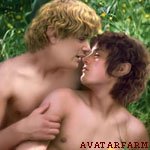 The results are in!
The results are in!
We sponsored a geek poetry contest with GeekMom.com and here are the winning poems.
Readers of Geek Mom were asked to submit a poem in any form of their choosing (haiku, rap, free verse, Klingon sonnet) on any geeky topic: Tolkien, Star Wars, Star Trek, gelatinous cubes, World of Warcraft war chants, hobbit drinking songs, odes to Harry Potter, ballads to honor Gary Gygax.
Sample winning haiku:
Samwise and Frodo:
You think they’re about to kiss,
But they never do.
--Natalie Jones
Poems that somehow managed to work in the name "Ethan Gilsdorf" (which, according to legend, is either Elvish or Elvis) were hard to resist. Winners got autographed copies of Fantasy Freaks and Gaming Geeks: An Epic Quest for Reality Among Role Players, Online Gamers, and Other Dwellers of Imaginary Realms.
Hope you enjoy! The rest of the bards' fabulous winning works can be read here.
You can also read the other non-winning but nonetheless worthy entries here
We all role-play now
[Note: Ethan Gilsdorf speaks at the Boston Public Library Wed, Oct 20. Other upcoming speaking engagements: Attleboro, MA: Oct. 29th (part of a Creature Double Feature tribute!); Brattleboro, VT: Nov 11th; Somerville, MA: Nov 13th; Cambridge, MA: Nov 15th; Providence, RI: Nov 18th; Burlington, MA: Nov 20th; Brooklyn, NY: Nov 22nd. More book tour info here]
We all role-play now
Those Dungeons & Dragons skills can come in handy in the world of Facebook
"The Social Network,'' Hollywood's latest box office king, charts Facebook's meteoric rise to near ubiquity. Few have not heard of the world-girdling website or been ensnared by its tendrils. In six years, Facebook has woven its way into the daily lives of some 500 million users.
Whether to check up on friends' exploits or play games like "Mafia Wars,'' we've grown accustomed to its promise of instant intimacy and, some might argue, its voyeuristic pleasures. Many cheer the way Facebook has democratized the flow of information; no longer top-down, news is now horizontally and virally dispersed. Others gripe that it's warped our idea of significance, making what I had for breakfast as important as the latest developments in the Mideast peace process. Facebook's vast and sticky web of connection has caused us all to re-evaluate what we mean by "friend.'' And, I suppose, "enemy'' as well.
Unforeseen social aftershocks such as these have rippled in Facebook's wake. Others have yet to be detected. But there's something else at work with Facebook. It's actually making role-players of us all.
 Role-playing? Like that conflict-resolution exercise your sales team endured last year? Or role-playing, as in Dungeons & Dragons - that strange and wondrous game I (and perhaps you) played back in the Reagan administration, rolling dice in a basement and slaying goblins and dragons and snarfing bowls of Doritos?
Role-playing? Like that conflict-resolution exercise your sales team endured last year? Or role-playing, as in Dungeons & Dragons - that strange and wondrous game I (and perhaps you) played back in the Reagan administration, rolling dice in a basement and slaying goblins and dragons and snarfing bowls of Doritos?
I'd argue all these experiences - including posting a witty Facebook update - are cut from the same role-playing cloth. We all share that desire to be someone else. To be better, stronger, faster; to appear more handsome, more clever, more attractive than our fleshy selves might ever be. "My, aren't we having fun?'' say our photos, snapped while we're half drunk and posted in a day-after haze. On my Match.com profile, I offer clues that might seduce. I suggest, in a whisper of pixels, "I am your ideal man.''
Not that role-playing is devious. It's a necessary counter to the way we've been civilized. While hidden behind the screen, we give ourselves permission to behave more dauntless or brazen than we'd allow in real life. We get to practice being the best version of the person we can be, or want to be.
That said, some role-playing experiences, especially offline ones, are deemed more acceptable than others. Dressing up as Tom Brady and painting your body blue and red for the big game? That's OK. Dressing as Gandalf and wearing a purple wizard hat for the big game? Not so much. Even as World of Warcraft and D&D and Harry Potter fandom have become passable in many circles, adults raiding Mom's closet for goofy clothes for "make-believe'' still remains verboten.
Except, of course, at Halloween. This odd holdover from pagan times is a socially acceptable way to bust loose. Here, costumes are fine. And playing "bad'' is encouraged. Being Dracula or Nurse Hottie for an evening can be instructive, even liberating.
The irony here is that even in our pre-Facebook existences, we've always engaged in day-to-day role-playing. At a wedding or cocktail party, on a first date or during a job interview, or when home for the holidays, we all dress the part and adopt another character: Brilliant or Well Adjusted, Stockbroker or Salesman, Happy Son or Perfect Mom. If you're not willing to play along and put on a mask, friends (and potential employers) will think, "What's wrong? Come on, get into character.'' Life is a dungeon crawl, full of monsters and opportunities to be on your mettle. Be prepared. Chin up.
So here's the rub. Eventually, we have to live up to these personas we've created. Many a first date has witnessed the crumbling of expectation's towers and spires. And despite my hundreds of Facebook friends, I wonder who I can really count on in times of trouble. When I really do need to be brave and slay that dragon.
Ethan Gilsdorf is author of Fantasy Freaks and Gaming Geeks: An Epic Quest for Reality Among Role Players, Online Gamers, and Other Dwellers of Imaginary Realms, now in paperback. More info on Gilsdorf and the book here.
On the appeal of fantasy role-playing games
 One of the author's D&D dungeon maps
One of the author's D&D dungeon maps
We craved adventure and escape.
When people ask if I played sports in high school back, I tell them I was on the varsity Dungeons & Dragons (D&D) team, starting quarterback, four years in a row. (I was also president of the A/V club. And I memorized Monty Python sketches. And learned BASIC computer programming.) For me, RPGs (role-playing games) like D&D were empowering and exciting, and a clever antidote to the anonymity, monotony, and clique warfare of high school. In lieu of keg parties or soccer practice to vent our angst, we had D&D night. Who needs sports stardom when you can shoot fireballs from your fingertips?
I played every week, sometimes twice a week, from eighth grade to senior year, Friday night from 5:00 p.m. until midnight. JP, my other neighborhood friend Mike, and I first played by ourselves, then found a peer group of other gamers: Bill K., Bill S., Bill C., Dean, Eric M., Eric H. and John. Some of us had endured plenty: my Mom had suffered a brainaneurysm and came home damaged goods; Eric H.’s mom had died, John’s dad had suffered a brain injury similar to my mom’s, and JP was born with a disease that caused brittle bones, cataracts, and stunted growth.
I think on some level we knew we didn’t fit in. Perhaps we were weird. Girls were scarce commodities for us, and our group may have proved that tired cliché that outcasts, dweebs, and computer nerds couldn’t handle reality, let alone get a date for the prom. But nothing stopped us from playing, and the popular kids didn’t really care one way or the other. We were left alone to our own devices: maps, dice, rule books, and soda. It didn’t take long before words like halberd and basilisk became part of my daily vocabulary. Like actors in a play, we role-played characters—human, Elvish, dwarven, halfling—who quickly became extensions of our better or more daring selves. We craved adventure and escape.
One of us would be the Dungeon Master (DM) for a few weeks or months. Games lasted that long. The DM was the theater director, the ref, the world-builder, the God. His preprepared maps and dungeons, stocked with monsters, riddles, and rewards, determined our path through dank tunnels and forbidding forests. Our real selves sat around a living room or basement table, scarfing down provisions like bowls of cheese doodles and generic-brand pizza. We outfitted our characters with broad- swords, battle-axes, grappling hooks, and gold pieces. “In game,” these characters memorized spells and collected treasure and magic items such as +2 long swords and Cloaks of Invisibility and Rods of Resurrection. Then, the adventure would begin. The DM would set the scene: often, we’d be a ragtag band of adventurers who’d met at the tavern and heard rumors of dungeons to explore and treasure to be had. Or some beast or sorcerer terrorizing the land needed to be slayed. Before too long, we’d enter some underground world to solve riddles, search for secret doors, and find hidden passages.
We parleyed with foes—goblins, trolls, harlots—and attacked only when necessary. Or, wantonly, just to taste the imagined pleasure of a rough blade running through evilflesh. We racked up experience points. We test-drove a fiery life of pseudo-heroism, physical combat, and meaningful death. Whatever place the DM described, as far as we were concerned, it existed. Suspended jointly in our minds, it was all real. We were bards, jesters, and storytellers. We told each other riddles in the dark.
And each dungeon level would lead to the next one even deeper beneath the surface, full of more dangerous monsters, and even harder to leave.
At Least There Was a Rulebook
The joy in the game was not simply the anything-can-happen fantasy setting and the killing and heroic deeds, but also the rules. Hundreds of rules existed for every situation. Geeks and nerds love rules. D&D (and its sequel, AD&D, or Advanced Dungeons & Dragons) let us traffic in specialized knowledge found only in hardbound books with names like Monster Manual and Dungeon Masters Guide. As we played, we consulted charts, indices, tables, descriptions of attributes, lists of spells, causes and effects—like a school unto itself, filled with answers to questions about the rarity of magic items, crossing terrain, and how to survive poison.
And we loved to fight over the minutiae. (Sample argument: Player: “What do you mean a gelatinous cube gets a plus on surprise?” DM: “It’s invisible.” Player: “But it’s a ten foot cube of Jello! Let me see that . . . .” Player grabs Monster Manual from DM. Twenty minute argument ensues.)
We could tell a mace from a morning star, a cudgel from a club, and we knew how to draw them. We knew a creature called a “wight” inflicted one to four hit points of damage when it attacked. Could we recharge wands? No. If I died, I could be resurrected, because, according to page 50 of the Players Hand- book, a ninth-level cleric could raise a person who had been dead for no longer than nine days. “Note that the body of the person must be whole, or otherwise missing parts will still be missing when the person is brought back to life.” All good stuff to know. The trolls and fireballs may be fanciful, but they have to behave according to a logical system.
Like in life, fantasy rules were affected by chance—the roll of the dice. And, as if they were jewels, we collected bags of them: plastic, polyhedral game dice, four-, six-, eight-, ten-, twelve-, and twenty-sided baubles that, like I Ching sticks or coins, foretold our fortunes when cast. A spinning die, such as the icosahedral “d20,” could land on “20” (“A hit! You slice the lizard man’s head off and green blood spurts everywhere!”) as often as “1” (“Miss! Your sword swings wide and you stab yourself. Loser!”).
The lesson? Real life thus far had taught me that in the adult world, fate was chaotic and uncertain. Guidelines for success were arbitrary. But in the world of D&D, at least there was a rule book. We knew what we needed to roll to succeed or survive. The finer points of its rules and the possibility of predicting outcomes offered comfort. Make-believe as they were, the skirmishes and puzzle-solving endemic to D&D had immediate and palpable consequences. By role-playing, we were in control, and our characters—be they thieves, magic-users, paladins, or druids—wandered through places of danger, their destinies, ostensibly, within our grasp.
At the same time, we understood that our characters’ failures and triumphs were decided by unknown forces, malevolent or kindly. Such was the double-edged quality of our fantasy life, where random cruelty or unexpected fortune ruled the day. The game was a risk-free milieu for doing adult things.
It was also a relief to live life in another skin, and act out behind the safety of pumped-up attributes. D&D characters had statistics in six key areas: strength, intelligence, wisdom, dexterity, constitution, and charisma. These ranged from three to eighteen. Ethan the real boy’s stats would have been all under 10; his fighter character Elloron’s were all sixteens, seventeens, and eighteens.
And who wouldn't want to be that?
[adpated from Ethan Gilsdorf's award-winning travel memoir and pop culture investigation Fantasy Freaks and Gaming Geeks: An Epic Quest for Reality Among Role Players, Online Gamers, and Other Dwellers of Imaginary Realms, now available in paperback. For more info, see: http://www.ethangilsdorf.com/]
 The author's old, worn-out D&D dice
The author's old, worn-out D&D diceDungeons & Dragons Saved My Life
 The author, circa 1982
The author, circa 1982
The summer before my eighth-grade year, when I was 12, I learned to escape.
This was 1979. My mother had been home from the hospital for a few months, and my sister, brother and I were still coming to understand the “new Mom.”
This new mother had survived a brain aneurysm. Her left side was mostly paralyzed, and she behaved strangely. Sometimes she scared me. We called her the Momster.
I couldn’t tame her, not this beast, and I knew I couldn’t save her, either. I was stuck with a mother I didn’t know how to love
But later that summer, something wondrous happened—I learned how to face my demons in another way. I learned that sometimes, checking out from reality was not just a fun diversion, but necessary for survival.
 An article about that mysterious, possibly dangerous, new game fad D&D
An article about that mysterious, possibly dangerous, new game fad D&D
A new kid named JP had moved across the street from me. One hot August day, JP showed me a clever trick—how to step away from my own body and mind, my family, and travel to places I’d never even seen. A way out.
“Ever play D&D?” JP asked, standing in my kitchen, eyes bright and magnified behind his extra-thick glasses. He was quite short, frail-looking, but feisty and fast-talking.
“D&D?” I said. “What’s that—a board game?”
“Dungeons & Dragons? It’s not a normal board game. . . . See, you play a character. . . . There’s all these rules.” He rummaged through his backpack and pulled out a pile of books, then poured a sack of colorful objects onto the table. They looked like gemstones. “Check out these cool dice! See, I’m the Dungeon Master. I create a scenario, man adventure, a world. You tell me what your character wants to do.”
“Character? What do you mean?” I asked. This kid was weird.
Invented by two geeks in the Midwest, Gary Gygax and Dave Arneson, the was only five years old back in 1979. Few had ever played anything like this before. Born of a similar swords-and-scorcery, myth-laden backdrop as J.R.R. Tolkien's world of Middle-earth, D&D was a game where you got to take action, be the hero, go on a quest. The game taught social skills, leadership, and strategy; it inspired creativity and storytelling, and provided rites of passage, accomplishment and belonging, even belief systems. I didn't get it at the time, but D&D and its ilk let people safely try out aspects of their personalities --- often dark, evil sides, or extroverted or flirtatious --- they could not or would not flex in "real life." The games connected folks tomagical thinking, to nature, to a primal, pick-up-your-battle-ax and kill mentalities long suppressed by so-called society. All of which would later serve me well in life.
D&D would open up a universe of creative expression to shy, introverted, non-athletic kids like me who felt about as powerful as a three-foot hobbit on the basketball team.
But at the moment, I was confused. I had no idea how play.
JP sighed. “OK, it goes like this. Pretend you’re in a dark woods. Up ahead on the path, you see a nasty-looking creature: seven feet tall, pointy ears, mouth full of black rotten teeth. ‘Friend or foe?’ it grumbles. Its fist tightens on the morning star in his hand, and it begins to heft it. Like this.” JP grabbed a frying pan off the stove. He swung it in the air. “What do you do?”
“What do I do?”
“It’s an orc. What do you want to do?”
“Uh . . . ” I stalled. What is going on? I thought. I didn’t even know what a morning star was. Or an orc.
"What are you going to do?" JP asked again, a little more impatiently.
“Uh, I’ll attack? With my sword. Do I have a sword?”
JP rolled the dice and squinted at a rulebook. “OK, your short sword strikes its shoulder. Black blood spurts out. It screams, ‘Arrghhh!’ You whack it for four hit points.”
“Cool.” I wanted to ask what a “hit point” was, but it didn’t matter. My anxiety, my weird home life, my mother’s limp, all of it began to fade. I was hooked. I didn’t know it at the time, but Dungeons & Dragons was about to save my life.
“Now the orc comes charging at you. He’s really mad.” JP bared his teeth for effect. “Now what do you do?” he asked, a big grin spreading across his face.
What do I do? I was 12. It was 1979. I had just discovered the power of escape, and vicarious derring-do. Later, I would learn much more about orcs and morning stars and a universe of wondrous things. There was so much I wanted to do.
Who needs varsity sports when you can be a wizard and shoot fireballs from your fingertips?
 Adapted from the Prologue to Ethan Gilsdorf's travel memoir and pop culture investigation Fantasy Freaks and Gaming Geeks: An Epic Quest for Reality Among Role Players, Online Gamers, and Other Dwellers of Imaginary Realms, now in paperback. More info:http://www.ethangilsdorf.com
Adapted from the Prologue to Ethan Gilsdorf's travel memoir and pop culture investigation Fantasy Freaks and Gaming Geeks: An Epic Quest for Reality Among Role Players, Online Gamers, and Other Dwellers of Imaginary Realms, now in paperback. More info:http://www.ethangilsdorf.com
Geek Out!
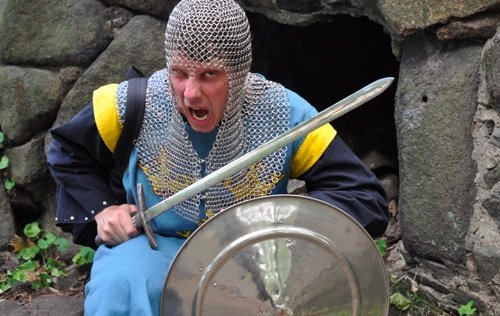 Like when the planets align, there are a few times each year when geeks can fly their freak flags high and proud, in vast numbers, and at the same time in different parts of the universe.
Like when the planets align, there are a few times each year when geeks can fly their freak flags high and proud, in vast numbers, and at the same time in different parts of the universe.
This coming Labor Day is one of those weekends.
On the west coast, we have Pax, in Seattle, a three-day game festival for tabletop, videogame, and PC gamers and a general celebration of gamer-geek culture. (And in the other corner, Atlanta, we have Dragon*Con. But more on that another time.)
In fact, Pax calls itself a festival and not a convention because in addition to dedicated tournaments and freeplay areas (The east coast version in Boston this spring had a very cool classic arcade game room, which was amazing! All your fave games like Frogger, Galaga and my fave, Robotron 2084), they’ve got nerdcore concerts from awesome performers like MC Frontalot and Paul & Storm, panel discussions like “The Myth of the Gamer Girl,” the Omegathon event (A three-day elimination tournament in games from every category, from Pong toHalo to skeeball), and an exhibitor hall filled with booths displaying the latest from top game publishers and developers.
But I was thinking that probably the best part of PAX (and similar events like Dragon*Con, the other big fantasy/science fiction fandom event of the year) is this: You get to hang out with kindred folk who love their games and books and movies and costumes. They will argue and defend their fandom universes to the death. They will argue why Tom Bombadil should not have been cut from Peter Jackson’s Lord of the Rings. They will battle over Kirk vs. Picard. They will annoy and astound you with their detailed, persnickety knowledge.
In other words, a geek is less what someone loves as it is HOW they love that object of affection. Geeks are passionate about their thang before it became fashionable and long after it’s passed from the public eye. Perhaps that’s the best definition of a geek.
If you’re headed to Atlanta or Seattle this weekend, check here for how to win a free copy of my book Fantasy Freaks and Gaming Geeks, now out in paperback.
Ethan Gilsdorf is the author of the award-winning travel memoir-pop culture investigation Fantasy Freaks and Gaming Geeks: An Epic Quest for Reality Among Role Players, Online Gamers, and Other Dwellers of Imaginary Realms, now out in paperback. You can reach him and get more information at his website www.ethangilsdorf.com.
Proposed Gygax monument
As reported in the Janesville Gazette (WI) today, the family of E. Gary Gygax has announced plans for a memorial to Gygax in his hometown of Lake Geneva, Wisconsin, the town where Dungeons & Dragons was founded. (In Fantasy Freaks and Gaming Geeks, I head off to Lake Geneva in search of Gygax and his legacy.)
Apparently, Gygax was into the idea. And who wouldn't be? (and who wouldn't want to be memorialized in this way?). What would the monument look like? Perhaps a statue, perhaps something else. A maze? An animatronic wizards or dragon spewing fireballs? An endlessly rotating d20?
Upon hearing the news, in a spare moment at my local cafe (where much of my book was written), I scribbled down a possible design idea. Thoughts?
